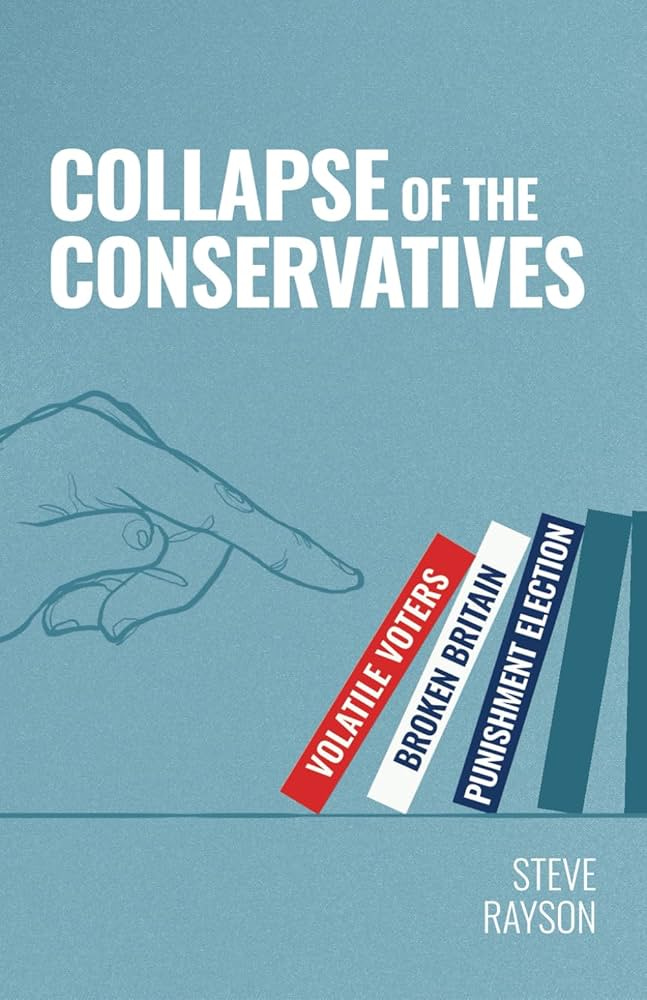Collapse of the Conservatives by Steve Rayson
Welcome to the fifth of my write-ups of the books about the 2024 general election. This time it is Steve Rayson’s Collapse of the Conservatives: Volatile Voters, Broken Britain and a Punishment Election, which the author gave me a review copy of.
To get future reviews direct to your inbox, sign up here:
Steve Rayson, author of one of the best titled books about British politics (Badgeland: Memoir of a Labour Party Young Socialist in 1980s Britain), is back with a book about the 2024 general election.
Flick to the end of the book and you find 27 pages of endnotes, nearly all of which are web addresses. That gives you the flavour of this book: it is a thorough, poll based narrative of how the Conservatives lost in 2024, drawing heavily on existing public information. There is a detailed narrative but very little original reporting or analysis beyond a nicely drawn framework that gives a structure to the story, focusing on how the public concluded that nothing worked any more, that the Conservatives were incompetent and that they should be punished as a result.
The first piece of polling data is presented three sentences in and the book does not let up from there with a barrage of poll numbers, electoral statistics and quotes from professors of political science. It is not a book of revelations of new information and fresh quotes from anonymous sources, but rather a handy compilation of already public information. Even events like the tractor porn scandal get little colour or drama. It is the opposite of a Tim Shipman book in that respect.
The barrage of statistics approach makes Collapse of the Conservatives a handy reference guide and roots its account in evidence of what the public really thought. Though a little bit of duplication that creeps in, the book moves along briskly through a comprehensive account.
At times, it would be handy if there was a little more analysis, especially where different statistics or quotes from political scientists point in different directions. On consecutive pages, for example, we get told that, “Labour’s landslide owed a great deal to Reform’s success” and then that, “less than a third (31%) of those who voted for Reform said they would have voted Conservative in the absence of a Reform candidate”.1 It is left to the reader to figure out how best to reconcile those two, or which to pick to go with.
Similarly, several different definitions of the Blue Wall or Red Wall are mentioned or used through the book, without careful analysis of the pros and cons of which definition is most useful or the differences between them.
As a reference work, however, that is a strength as it means the book sets out competing approaches rather than supplanting them with just the author’s one interpretation.
If you followed the election closely, the book contains little that will be new to you. But if you continue to think about the election in the months and years to come, the book contains in a handy single reference volume much that you will want to refer to again.
Finally, the Pack Mention Index (PMI™)1 comes in reassuring low at 1.
Get the book
You can get your own copy of Steve Rayson’s Collapse of the Conservatives:
The next book
My plan is for the next book is … unclear as there appears to be a little gap now in the flow of election books coming out. Having mentioned Tim Shipman above, I may drop in a review of his latest book which, although also about much else, also covers the general election. Stay tuned to find out.
The previous books
Anushka Asthana’s Taken As Red: How Labour Won Big and the Tories Crashed the Party.
Lord Michael Ashcroft’s Losing it: the Conservative Party and the 2024 general election.
Tim Ross and Rachel Wearmouth’s Landslide: The Inside Story of the 2024 Election.
Patrick Maguire and Gabriel Pogrund’s Get In: The Inside Story of Labour Under Starmer.
Links to books include affiliate links which generate a small commission for each sale.
p.207 and p.208.


